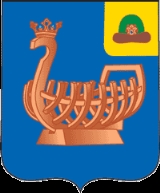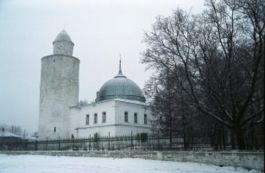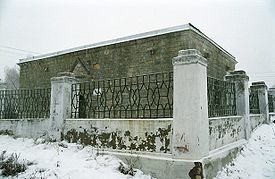
Kasimov
Encyclopedia
Kasimov is a town in Ryazan Oblast
, Russia
, which serves as the administrative center of Kasimovsky District
(from which it is administratively separate). The town is situated on the left bank of the Oka River
. Population: 17,000 (1910); of which about 2000 speak Tatar language.
tribe called the Meshchyora, later assimilated by Russians
and Tatars
. The town was founded in 1152 by the Vladimir-Suzdal
ruler Yury Dolgoruky as Grodets, then Gorodets Meschyorsky . It was included in the Mishar Yort division of the Golden Horde
, but then was sold to Muscovy.
In 1376, the town was destroyed by the Mongol invaders, but was soon bebuilt as Novy Nizovoy (New Low-lying) town. After the Battle of Suzdal
in 1445 (in which Great Duke Vasili II
was taken prisoner), the Meschiora lands were given to Olug Moxammat, khan of Kazan Khanate as a ransom for the sovereign's life.
In 1452, Great Duke Vasili II of Muscovy gave this town to Kazan prince Qasim khan
, who served as tribute inspector of the Great Horde
, but then came to Russian service. By other accounts, Qasim and his brother Yosif fled from Kazan after losing their bid for the throne against their brother Mäxmüd
. After 1471, the town was known as Qasím city. It remained the capital of Qasim Khanate
until 1681 when the khanate was reabsorbed into Russia.
A group of Tatars settled there in 15th century and are now known as Qasim Tatars
. They speak the Mishar dialect, mixed with the Middle Tatar dialect of the Tatar language
.

 In the 17th century, the town was separated into three parts:
In the 17th century, the town was separated into three parts:
Historical buildings:
Ryazan Oblast
Ryazan Oblast is a federal subject of Russia . Its administrative center is the city of Ryazan, which is the oblast's largest city. Population: -Geography:...
, Russia
Russia
Russia or , officially known as both Russia and the Russian Federation , is a country in northern Eurasia. It is a federal semi-presidential republic, comprising 83 federal subjects...
, which serves as the administrative center of Kasimovsky District
Kasimovsky District
Kasimovsky District is an administrative and municipal district , one of the 25 in Ryazan Oblast, Russia....
(from which it is administratively separate). The town is situated on the left bank of the Oka River
Oka River
Oka is a river in central Russia, the largest right tributary of the Volga. It flows through the regions of Oryol, Tula, Kaluga, Moscow, Ryazan, Vladimir, and Nizhny Novgorod and is navigable over a large part of its total length, as far upstream as to the town of Kaluga. Its length exceeds...
. Population: 17,000 (1910); of which about 2000 speak Tatar language.
History
The first population of this area was a FinnicFinno-Ugric peoples
The Finno-Ugric peoples are any of several peoples of Europe who speak languages of the proposed Finno-Ugric language family, such as the Finns, Estonians, Mordvins, and Hungarians...
tribe called the Meshchyora, later assimilated by Russians
Russians
The Russian people are an East Slavic ethnic group native to Russia, speaking the Russian language and primarily living in Russia and neighboring countries....
and Tatars
Tatars
Tatars are a Turkic speaking ethnic group , numbering roughly 7 million.The majority of Tatars live in the Russian Federation, with a population of around 5.5 million, about 2 million of which in the republic of Tatarstan.Significant minority populations are found in Uzbekistan, Kazakhstan,...
. The town was founded in 1152 by the Vladimir-Suzdal
Vladimir-Suzdal
The Vladimir-Suzdal Principality or Vladimir-Suzdal Rus’ was one of the major principalities which succeeded Kievan Rus' in the late 12th century and lasted until the late 14th century. For a long time the Principality was a vassal of the Mongolian Golden Horde...
ruler Yury Dolgoruky as Grodets, then Gorodets Meschyorsky . It was included in the Mishar Yort division of the Golden Horde
Golden Horde
The Golden Horde was a Mongol and later Turkicized khanate that formed the north-western sector of the Mongol Empire...
, but then was sold to Muscovy.
In 1376, the town was destroyed by the Mongol invaders, but was soon bebuilt as Novy Nizovoy (New Low-lying) town. After the Battle of Suzdal
Battle of Suzdal
The Battle of Suzdal or the battle of the Kamenka river was fought of July 7, 1445 between Russians under Vasily II and Tatars troops of Olug Moxammad, invaded the principality of Nizhny Novgorod. Russians were defeated by troops of beg Maxmud, who became Maxmud of Kazan some after the battle....
in 1445 (in which Great Duke Vasili II
Vasili II of Russia
Vasily II Vasiliyevich Tyomniy was the Grand Prince of Moscow whose long reign was plagued by the greatest civil war of Old Russian history....
was taken prisoner), the Meschiora lands were given to Olug Moxammat, khan of Kazan Khanate as a ransom for the sovereign's life.
In 1452, Great Duke Vasili II of Muscovy gave this town to Kazan prince Qasim khan
Qasim khan
Qasím Khan was the first khan of the Qasim Khanate, a Tatar khanate since 1450s. He was the son of Kazan khan Oluğ Möxämmäd....
, who served as tribute inspector of the Great Horde
Great Horde
- Dissolution of the Golden Horde :The peripheral regions of the Golden Horde broke off as follows: 1438: Kazan Khanate, 1441: Crimean Khanate, 1466: Astrakhan Khanate The remnant, which became known as the Great Horde, was left with the steppe between the Dnieper and Yaik, the capital Sarai and a...
, but then came to Russian service. By other accounts, Qasim and his brother Yosif fled from Kazan after losing their bid for the throne against their brother Mäxmüd
Maxmud of Kazan
Mäxmüd khan ; in Russian chronicles Махмутек ; ?-1467) was a ruler of the Kazan Khanate in , an elder son of Oluğ Möxämmäd. He is reputed to be one of the khanate's founders. He participated in his father's campaigns against Muscovy. In 1445, he won the battle of Suzdal and took captive the Grand...
. After 1471, the town was known as Qasím city. It remained the capital of Qasim Khanate
Qasim Khanate
Qasim Khanate or Kingdom of Qasim was a Tatar territorial formation , vassal of Russia, which existed from 1452 till 1681 in the territory of modern Ryazan Oblast in Russia with its capital Kasimov, in the middle stream of the Oka River...
until 1681 when the khanate was reabsorbed into Russia.
A group of Tatars settled there in 15th century and are now known as Qasim Tatars
Tatars
Tatars are a Turkic speaking ethnic group , numbering roughly 7 million.The majority of Tatars live in the Russian Federation, with a population of around 5.5 million, about 2 million of which in the republic of Tatarstan.Significant minority populations are found in Uzbekistan, Kazakhstan,...
. They speak the Mishar dialect, mixed with the Middle Tatar dialect of the Tatar language
Tatar language
The Tatar language , or more specifically Kazan Tatar, is a Turkic language spoken by the Tatars of historical Kazan Khanate, including modern Tatarstan and Bashkiria...
.
Layout and landmarks


- Old Town (Russian: Старый Посад; Tatar: İske Bistä) and Tatar Town (Russian: Татарская слобода; Tatar: Tatar Bistäse) regulated by khan of Qasim Khanate and Tatar noblemen;
- Yamskoy Town (Russian: Ямская слобода) of Russian commoners, regulated by MoscowMoscowMoscow is the capital, the most populous city, and the most populous federal subject of Russia. The city is a major political, economic, cultural, scientific, religious, financial, educational, and transportation centre of Russia and the continent...
; - Marfin Town (Russian: Марфина слобода, Tatar: Marfin Bistäse) – part of the city, regulated by Kasimov voyevodas – Russian governors.
Historical buildings:
- Stone mosque (1467)
- Mausoleum of Shahgali (Şahğäli) Khan (1555)
- Mausoleum of Afghan MoxammadAfghan MoxammadÄfğan Möxämmäd khan [af-GHAHN mer-kham-MAT] was the ruler of Qasim Khanate, 17th century....
(Äfğan Möxämmäd) Khan (1658) - Russian Orthodox churches:
- Church of the EpiphanyEpiphany (Christian)Epiphany, or Theophany, meaning "vision of God",...
17th century; - St. Nicholas Church 17th century;
- TrinityTrinityThe Christian doctrine of the Trinity defines God as three divine persons : the Father, the Son , and the Holy Spirit. The three persons are distinct yet coexist in unity, and are co-equal, co-eternal and consubstantial . Put another way, the three persons of the Trinity are of one being...
Church 17th century; - Cathedral of the Ascension 19th century.
- Church of the Epiphany

